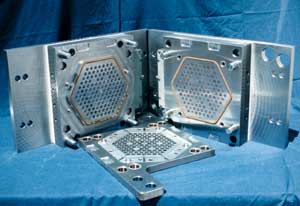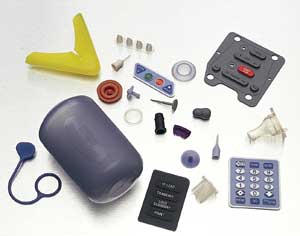Liquid silicone grows up in medical market
July 29, 2002
|
Tooling for liquid silicone molding is more self-contained than conventional molds. Each mold has its own cartridge heaters, thermocouples, and insulation for better portability. |
Injection molding liquid silicone rubber (LSR) is tricky business, and it isn't something with which a lot of molders have expertise. Even fewer mold shops understand the nuances of building a tool to mold liquid silicone. M.R. Mold & Engineering (Brea, CA) is one of a handful of shops in the U.S. that is dedicating its resources to gaining and maintaining a cutting edge in this technology that is seeing its best opportunities in medical applications.
Rick Finnie, president of M.R. Mold, has been building tools for liquid silicone molding for most of his career. An increase in demand for molds in this arena, however, has driven the company to invest in an Engel liquid silicone press so that M.R. Mold can test molds as well as perform R&D on the development of cold runner systems.
"Something is needed to perfect this process. Automation and a better mold are the answers," says Finnie. For years, he points out, molders of liquid silicone have lived with the problems of flash and the waste of runner systems. "They've just put up with it because there was no alternative," Finnie adds. "Now, customers are demanding no flash and no waste. We've got some catching up [to do] with the Europeans in this regard. We're working with Kipe Molds on developing cold runner systems and automation, trying to compete with the Austrians in this arena."
Finnie recommends using a moldmaker that has experience in liquid silicone molding and moldmaking because of the many idiosyncrasies of the process. "There's a lot that is completely different about LSR molds vs. regular thermoplastic molds," he adds.
Not Your Standard Tool
To develop his expertise in this special process, Finnie recently traveled extensively researching cold runner technology for these molds. Tooling for liquid silicone molding differs from conventional molds in that it is more self-contained, Finnie explains. "Each mold has its own cartridge heaters, its own thermocouples and insulation, and therefore can move from press to press very easily. Runners and gates can be very small because liquid silicone flows so easily. However, it also flashes easily, so tight fits and tolerances are critical."
To overcome problems with flashing, Finnie uses hardened tool steel in the cavities and cores, and mold base plates are made out of 420 stainless steel. Shutoffs have to be right on, Finnie emphasizes. "Conventional ejector pins will flash because they're not accurate enough," he says. "We use custom ejector pins that are exactly round, or reverse-taper ejector pins."
Air trap is also a big challenge, Finnie notes. "We have to be careful with venting because molders are worried about flash in the vent." One solution is to pull a vacuum on the mold. "It's a real Catch-22," Finnie says. "Some customers don't like vents in the mold, but it's a necessary evil."
|
Molded medical products have benefited from liquid silicone rubber thanks to its clean processing and excellent cure rate—around 1 mm in 5 seconds. |
Ideal Applications
Finnie's success building tools for LSR molding applications includes molds for parts that other shops said couldn't be made. In one instance, Finnie constructed a mold in which the core bar rotates out of the mold with a rack in order to remove the part from the mold.
Some of the components for which he has built molds include a reseal device that is inserted into IV lines to allow for the injection of medication directly into the line. "They've tried to eliminate the use of needles as much as possible," notes Finnie. "In these needleless sites, they can inject a supplemental medication, and when they pull the syringe out, it has to reseal."
Because of the peculiarities of LSR, conventional thinking is that these molds can't run automatically. Finnie has proved that wrong, too. "We can run liquid silicone under full automatic conditions," he says. "In fact, you can't work out the bugs until the mold runs fully automatic."
Liquid silicone rubber is ideal for medical molding applications, Finnie notes. "The whole process is so clean. The material comes in 5- or 55-gal drums, which is then pumped out directly into the barrel of the molding machine, so there are very few problems with contaminants in the material."
Liquid silicone rubber also has an excellent cure rate—about 1 mm in 5 seconds. "So, if you have a component with a 2-mm wall thickness, the part cures in 10 seconds," Finnie says. The bottom line is that molders can achieve fast cycle times—as low as 15 seconds.
Because liquid silicone rubber is inert, it doesn't cause problems that other rubber products do, such as skin irritation or allergic reactions. It's becoming a popular material for various medical uses like oxygen masks, not only for the medical industry, but for scuba diving equipment as well. M.R. Mold has also made tooling to produce the small, nasal cannulas for oxygen delivery systems, ear tips for stethoscopes, and masks for resuscitation bags used in emergency medical procedures. Liquid silicone is ideal for use in diaphragms or in applications in which any type of seal is required. Catheter tips and the Y portion of the catheter are molded of liquid silicone, generally overmolded onto the tubing.
Contact information |
You May Also Like




